Safety is a full-time job that doesn’t get any easier in the winter months when extreme temperatures, high winds, and wet conditions give safety managers and workers more to worry about. Workers who are exposed to cold environments are at risk for cold stress which can lead to dangerous conditions such as hypothermia, frostbite, trench foot, and chilblains. According to the US Bureau of Labor Statistics’ most recent Injuries, Illness, and Fatalities Report, nearly 14,000 workplace injuries could be attributed to ice, sleet, or snow.
There are many important winter safety tips workers can follow to stay safe this upcoming season, but one crucial step is providing warm and comfortable PPE. Because the market is full of options, safety experts from Magid, a North American PPE manufacturer and distributor, are providing 3 steps for choosing winter PPE.
1. Look for moisture-wicking and water-repellent material that can be worn in layers
When working in cold environments, workers may experience hypothermia or frostbite if they get wet and do not remove damp clothing quickly or warm themselves. Help keep workers dry and warm by providing them with water-repellent outerwear and a base layer of clothing that’s made from a moisture-wicking material. Moisture-wicking fabrics help keep workers dry by moving moisture caused by sweat to the clothing’s surface and away from the skin. Also, remember that layering is important during winter months, but be careful to avoid heavy layers that will restrict movement and prevent workers from getting the job done.
2. Buy Gloves with additional features such as water-repellent shells, thermal lining, and coatings for working in wet conditions
The term “lightweight” may only seem relevant to the warmer months, but lightweight gloves help improve dexterity while keeping workers’ hands dry and comfortable. Look for gloves that maintain dexterity but have additional features such as water-repellent shells, thermal lining to help keep the hands warm, and coatings to help maintain grip in wet conditions.
3. Consider Hi-Vis options
Clouds, snow, and sleet are consistent in many winter forecasts making it harder to see workers on the jobsite. Plus, with shorter winter days, it’s likely workers may be on the job before sunrise or after sunset. Hi-vis PPE can help ensure your workers are being seen year-round.


